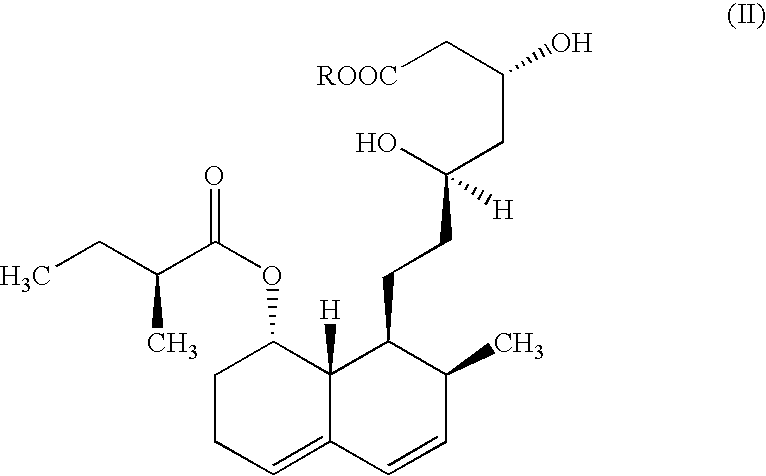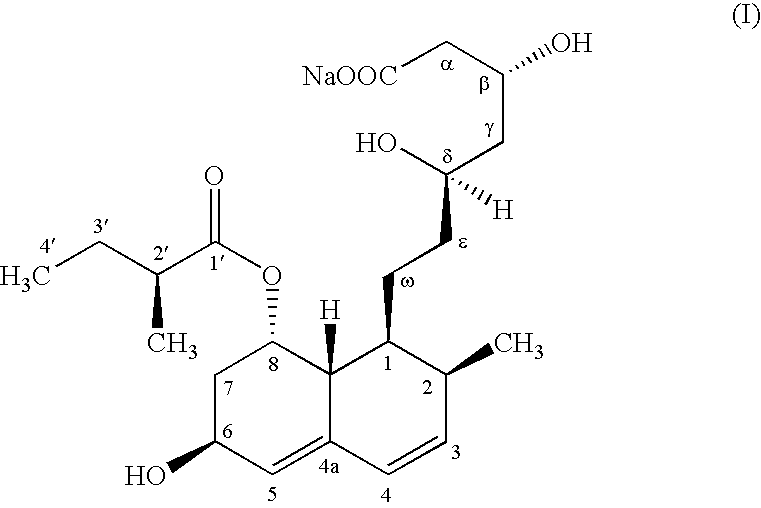Microbial process for preparing pravastatin
a pravastatin and microorganism technology, applied in the field of pravastatin preparation by microorganisms, can solve the problems of difficult and complex task of developing a cost-effective microbiological hydroxylation method for the manufacture of pravastatin, and microorganisms are not able to tolerate the substrate fed by compactin
- Summary
- Abstract
- Description
- Claims
- Application Information
AI Technical Summary
Problems solved by technology
Method used
Image
Examples
example 1
A spore suspension was prepared with 5 ml of a 0.9% sodium chloride solution obtained from a 7-10 day old, malt extract-yeast extract agar slant culture of Mortierella maculata nov. spec. E-97 [NCAIM(P)F 001266] strain able to 6.beta.-hydroxylate compactin and the suspension was used to inoculate 100 ml inoculum medium PI sterilized in a 500 ml Erlenmeyer flask.
Composition of the Medium PI:
Before the sterilization the pH of the medium was adjusted to 7.0, then it was sterilized at 121.degree. C. for 25 min. The culture was shaken on a rotary shaker (250 rpm, 2.5 cm amplitude) for 3 days at 28.degree. C., then 10 ml of the obtained culture was transferred into 100-100 ml bioconversion media MU / 4 sterilized in 500 ml Erlenrneyer flask for 25 min at 121.degree. C.
Composition of the Medium MU / 4:
Before the sterilization the pH of the medium was adjusted to 7.0, then it was sterilized at 121.degree. C. for 25 min.
Flasks were shaken on a rotary shaker (250 rpm, 2.5 cm amplitude) for 4 days...
example 2
In a laboratory scale fermenter with 5 liters working volume a MU / S bioconversion culture medium is prepared, the components of the culture medium are added corresponding to 5 liters, volume but it was loaded up only to 4.5 liters, then it was sterilized for 45 min at 121.degree. C. and seeded with 500 ml of the inoculum culture made according to the Example 1.
Composition of Medium MU / 8:
Before sterilization the pH of the medium was adjusted to 7.0 value.
The fermentation was carried out at 28.degree. C., with a stirring rate of 400 rpm and with an aeration rate from bottom direction 60 liters / hour for 4 days. At the 2nd day after the transfer the culture started to foam heavily, which can be decreased by the addition of further polypropyleneglycol 2000. At the beginning of the fermentation (16-20 hours) the pH decreased from the initial value of 6.5 to 5.0-5.5, then from the 3rd day it started to increase and reached 6.3-7.5 by the 4th day. The feeding of the compactin substrate is a...
example 3
In a laboratory scale fermenter with 5 liters working volume, bioconversion culture medium MU / 4 was prepared as described in Example 1, although it was loaded up to 4.5 liters, the composition of the culture medium was calculated to 5 liters. Then it was sterilized for 45 min at 121.degree. C. and inoculated with 500 ml of the inoculum culture made according to Example 1. The fermentation was carried out at 25.degree. C. by the application of a stirring rate of 300 rpm and an aeration rate of 50 liters / hour for 4 days. After 5 g compactin substrate feeding to the culture the bioconversion was carried out according to the Example 2.
After finishing the bioconversion, the 4.9 liters broth, which contained 660 .mu.g / ml pravastatin, was filtered and the separated mycelium was washed by suspension in 2.times.1 liter deionized water. The pH of the combined 5.6 liters filtrate of the broth was adjusted by 20% sulfuric acid to 3.5-3.7, then the acidic filtrate was stirred with 2750 ml ethyl ...
PUM
| Property | Measurement | Unit |
|---|---|---|
| concentration | aaaaa | aaaaa |
| thick | aaaaa | aaaaa |
| length | aaaaa | aaaaa |
Abstract
Description
Claims
Application Information
 Login to View More
Login to View More - R&D
- Intellectual Property
- Life Sciences
- Materials
- Tech Scout
- Unparalleled Data Quality
- Higher Quality Content
- 60% Fewer Hallucinations
Browse by: Latest US Patents, China's latest patents, Technical Efficacy Thesaurus, Application Domain, Technology Topic, Popular Technical Reports.
© 2025 PatSnap. All rights reserved.Legal|Privacy policy|Modern Slavery Act Transparency Statement|Sitemap|About US| Contact US: help@patsnap.com



